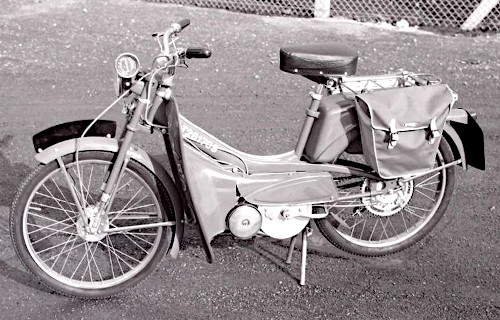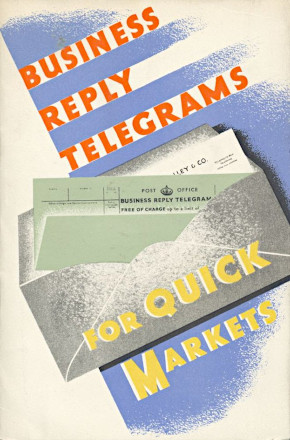
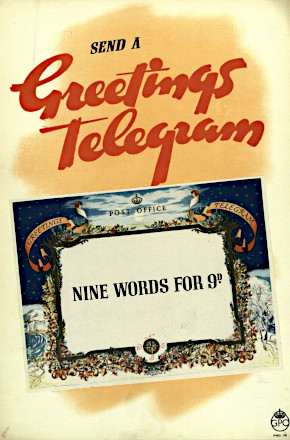
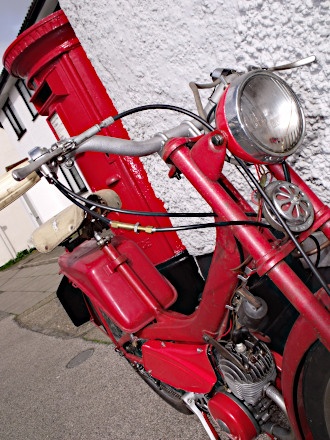
When British inventors William Cooke and Charles Wheatstone devised the electric telegraph system in the 1830s, it represented a major breakthrough in communications and came to be more commonly known as the Telegram in the 1850s.
It was particularly notable that the telegraph pre-dated the introduction of the ‘Uniform Penny Post’ on 10th January 1840 and, from the on 6th May, the sender could affix the first adhesive ‘Penny Black’ postage stamp as proof that postage had been paid.
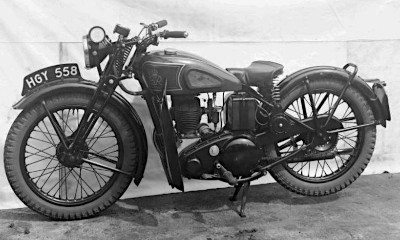
1945 GPO BSA
During the 1930s the General Post Office in Leeds introduced BSA B33-1 250cc motor cycles; 17-year-old boys were allowed to volunteer for rider and telegram training. Following the success of these, the GPO expanded motor cycle telegram deliveries across the country. This decade was acknowledged as the heyday of the service, delivering over 65-million telegrams each year—but also reportedly running at a £1M per annum loss.
Towards the mid 1960s, telegram volumes had dropped to around 10 million annually, as steady uptake of the telephone and use of telex was increasingly leaving too many General Post Office staff in too many places delivering an ever decreasing number of telegrams. Changes in driving licence regulations and the need to recruit more young postmen direct from school further led to the brief introduction of BSA Dandy 70cc scooters in 1962, which turned out to be the Dandy’s final year.
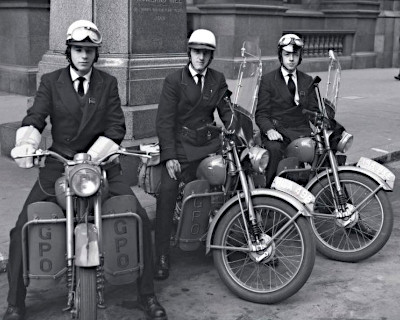
Telegram messengers on BSA Bantams in 1961
Six Raleigh RM5 Supermatic mopeds were subsequently purchased for suitability trials, and introduced for assessment on postal work use in 1962. These tests were judged as being quite successful in flat rural areas where relatively small mileages were involved, and further batches of Raleigh RM5 mopeds were ordered in 1963 and 1966. Their use was reportedly mainly for telegram delivery, but attempts were also being made to motorise rural letter delivery walks, where other kinds of motor transport had not previously been justified.
Another 50 Raleigh Supermatics were purchased in 1967 for rural postal and urban telegram delivery, though at £148 each were regarded as expensive, compared to £233 for a small postal van. This quantity of 50 mopeds had been overestimated for requirements, and the ‘excess’ was subsequently allocated to telegraph work instead.
Raleigh de-listed the RM5 Supermatic model in September 1969, at which point the more basic model Raleigh RM8 Runabout moped was purchased instead, while an additional trial of Honda mopeds was also taking place (which presumably would have been OHC model PC50’s).
The end of the decade saw the end of the General Post Office, when on the 1st October 1969 the government GPO department ceased to exist. It was replaced by the nationalised corporation, now simply called the Post Office. When the Post Office was formed in 1969 there were 1,500 vehicles allocated to telegram deliveries, though not all of these were motor cycles.
As far as vehicles were concerned, a major difference now was that all vehicles had to be individually licensed, and this work was devolved to local managers or head postmasters. The effect was that vehicles would no longer carry London registrations or be allocated to the national service in big batches of one type.
This had an immediate effect on the last batch of 120 BSA Bantams, as the machines ordered by the GPO were expected just before to the change. When BSA delivered this batch of Bantams in November 1969, they were among the first Post Office vehicles to carry local registrations.
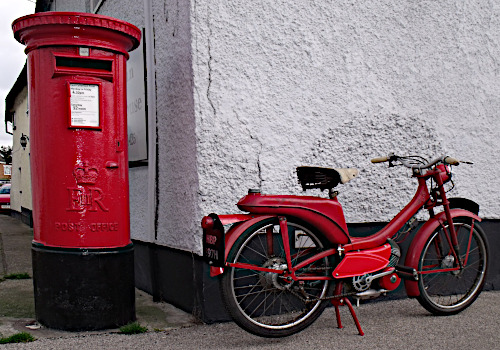
When the Mopedland workshops bought the Derek Scott collection, there was a Raleigh RM8 Runabout chassis that came along with it, which it would be somewhat generous to call a bike, because there was only a frame fitted with a pair of telescopic forks, a front wheel and front mudguard, and a fuel tank, but that was pretty much it. It turned out there was an old buff log-book with it which correctly related to the frame serial number, so the original registration number would be recoverable. It was decided that it might be worth building the rest up from parts as there were plenty of suitable components in the stores.
Since there was no sign of the original engine, another motor was built from stock components.
The frame was red, but what did seem a little odd was that the old buff log-book also indicated its colour as red—but we didn’t know of any RM8s ever being made in that as a factory colour?
As the cycle components were being assembled it was noticed there were two sticker numbers on the top of the front mudguard, 25. They hadn’t been noticed earlier because although they were originally white, they’d been overpainted in red, but they confirmed the suspicions that this was an ex-Post Office machine, since the Post Office marked the tyre pressures on all its motor cycle mudguards.
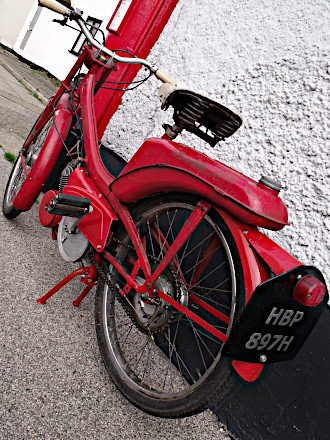
RM8 040768 was registered HBP 897H by West Sussex CC in April 1970, which is most surprising since Raleigh had posted discontinuance of the RM8 model in September 1969 … and at the same time as the RM5 Supermatic model which the PO didn’t buy because Raleigh had discontinued it? Puzzled as to how this adds up, we looked at the few known PO RM8 frame numbers that IceniCAM has managed to record, to see how this fits in with the numerical series.
Was this a special post-production batch of RM8s for the Post Office?
Might this represent the last frame numbers in the RM8 series?
040252 is the highest RM6 on the register before we get to three Post Office RM8s: 040346, 040598, and 040768, then our next recorded RM6 is 041023—so that looks like a batch of 500 RM8s. Then there’s one more later Post Office RM8: 043286, which must be a second batch, as our records of RM6 frame serials nearest on either side are 043057 & 043392 so clearly represents a much smaller batch of around 250 RM8s.
No question that the Post Office RM8s were the last of these models built, in what appears to have been two special post-production batches.
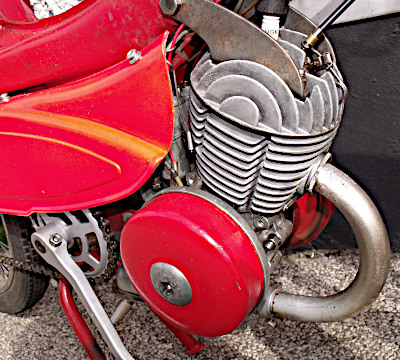
The later engine with its ‘split-fin’ cylinder has a larger exhaust port of 20×9mm and a higher compression cylinder head giving a ratio of 7½:1. With its Gurtner AR10mm carburettor this gives a power rating of 1.7bhp @ 4,500rpm.
The starting process begins by turning on the fuel tap, which is sited at bottom right of the large capacity 1⅜ gallon tank but, because of the depth of the tank at the front, the tap is located low down and needs some reaching down to pull out the plunger of the Ewarts tap.
Revisiting our on-the-stand starting technique, twist forward to decompress using the Amal twist grip, thumb the choke trigger on the left bar, kick with a pedal to spin the motor, then snatch back the throttle, and the motor fires up on the second attempt. To maintain running after cold starting requires the usual occasional tweaking of the choke trigger till the engine runs clean after 20-30 seconds, then we’re ready to go.
The RM8 wasn’t normally equipped with a speedometer, it came as an optional extra, which was an extra the Post Office seemingly didn’t opt for, so we’re tracked by our pacer taking readings on the test run.
The higher compression ratio helps with a better take-off using engine power alone and, although acceleration is also noticeably improved over the early 1.4bhp Runabout models, a little boost on the pedals still assists from a standing start. Due to the single drive ratio, once the automatic clutch bites at low speed, the initial phase feels quite laboured up to around 18mph, when the revs start to pick up, and the bike proves more flexible for general use in the 20mph range.
Happiest cruising speeds are found up to 27mph, above which things start getting a bit buzzy, and obtrusive vibrations begin to creep in through the saddle and pedals. Best on flat paced at 29, with 31 downhill, and it delivered a surprisingly strong uphill performance by cresting the rise at no less than 27mph!
The 80mm hub brakes worked very well at both ends.
Another feature of the RM8 was its headlamp, but which headlamp?
The original lamp fitted to early RM8 models was the Lucas MCH64, and the headlamp shell still stamped with P, O, M, and D switch positions, representing Off, Main and Dip functions, and the obsolete Park position in a throwback to the days of the old dry-cell battery assisted lighting sets on the preceding RM1 and RM2 models, from which the system was inherited. Raleigh was just using up old leftover stock.
Next was the first style of Wipac 5-inch diameter headlamp. This second original lamp for the RM8 is quite unusual in having an integral glass rim as part of the lens; other than a few period spotlights, it’s hard to recall many other lamps constructed like this. Behind the lens, the 4-inch diameter reflector should theoretically make better use of the generated light, but turning the Wipac switch on top of the headlamp either side to H & L, sometimes found there wasn’t much beam to report in either high or low positions—just a dim glow.
The third version was basically the same Wipac 5-inch headlamp, but now with a chrome plated steel rim and conventional glass lens replacing the preceding integral glass rim, and fitted to the same shell. This is the headlamp type our RM8 has.
Oh, what’s the light like? Same as usual, generally dull and yellow, because all three versions have the same 6V × 15/15W beam/dip bulb.
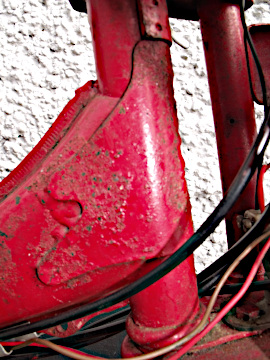
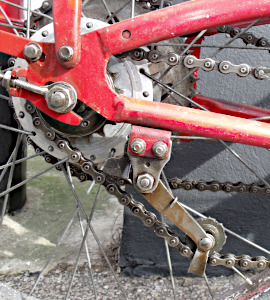
A special reinforcing plate is brazed into position around the headstock, and appears intended to stiffen and support the frame—we don’t think that we’ve seen this feature on any other Runabouts, so presume it might be a special addition fitted on demand of the Post Office. The shape of the formed plate certainly suggests a manufactured component rather than a home made addition. Also the PO RM8 frame is uniquely fitted with a different bracket to take a sprung pedal chain tensioner (like the RM5), where all other Runabout frames, including the RM11 and RM12, were fitted with fixed arm pedal chain tensioners.
The Post Office continued to experiment with other different moped manufacturers, with batches of 25 mopeds each from Honda, Garelli, Motobécane Mobylette and Steyr–Puch, all tested in 1970–71 as possible alternatives to the discontinued Raleigh RM8 Runabout.
BSA Bantams were, however, still in favour, with 100 being delivered in 1970 and the final batch of 400 arriving in 1970–71 before production ceased. The last machine delivered carried frame number BEO 07500. Many of this last batch of Bantams were put into store, and subsequently used to replace life-expired earlier examples after 1972, so that the last of these machines finally entered Post Office service in early 1974. Thus ended the 24-year marriage of the BSA Bantam with the GPO/PO. The total number of Bantams purchased by the Post Office was around 5,369.
However the PO did return to BSA in 1972 for one solitary purchase of an Ariel-3 moped for trial—which didn’t work out too well!
The Post Office subsequently chose Steyr–Puch as its standard moped supplier for the 1970s, purchasing 25 Puch Maxis in 1971, before settling on larger batches of Puch MV50D two-speed models from 1972 to 1979, adding up to 2,862 machines for postal and telegram delivery work.
The Post Office split with British Telecom, at which the telegram stayed with BT, so became a loss-making problem for another company.
Norton–Villiers–Triumph began introducing a new range of NVT Easy Rider ER1 and ER2 mopeds from March 1976, and the Post Office purchased two batches of 35 NVT Easy Rider mopeds for postal works.
In 1978 the Post Office introduced Express Post as a new premium service, which in most towns and cities used small vans for the delivery, however in the cities of Bristol and Oxford, four Honda CD175s were used for deliveries and became the first motor cycles (as opposed to mopeds), purchased by the Post Office since the last of the BSA Bantams in 1972.
When NVT changed to BSA branding after April 1979, the Post Office bought another batch of 35 BSA ER1 Mopeds as well as trying a batch of 35 Tomos 49cc mopeds, followed by 30 Honda NC50 two-speed Express mopeds being commissioned into service.
The telegram service seemed to be approaching its final days by the end of the 1970s, by when the telephone and telex systems had rendered it practically obsolete. By 1981 the ever-falling volume of telegram deliveries had now reduced the number of allocated vehicles engaged on the telegram service to just 400 nationwide.
Remarkably it wasn’t until 1st October 1982 that BT announced that the Telegram was to cease, though it actually continued for some while longer as the British Telecom Telemessage service, an overnight system for messages dictated over the phone or sent by telex, which were printed, and delivered next day by post.
Further Honda orders for City Express models were placed in the years 1987 to 2001, with 45 delivered annually.
In 1991 a new computerised telegram system (EMHS) was installed.
1994–99 saw the introduction of LoveGram, WeddingGram, BabyGram, & SantaGram.
In 2001 On-Line ordering was launched.
In 2002, orders for new delivery mopeds were cut to five machines … then just a single bike for 2003.
In 2003, TelegramsOnline took over the telegram service from BT.
In January 2005, two Honda Dylan SES 125cc motor cycles were purchased by Royal Mail for delivery in Central London on Sameday deliveries.
Royal Mail reportedly subsequently purchased more Honda 125cc motor cycles, and further took delivery of a ‘large order’ of Peugeot Ludix scooters.


